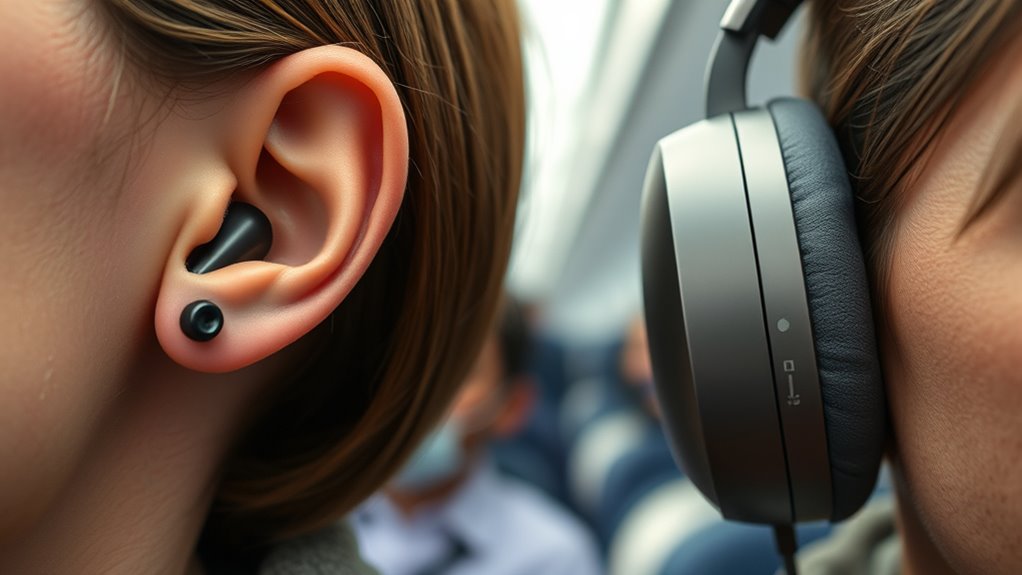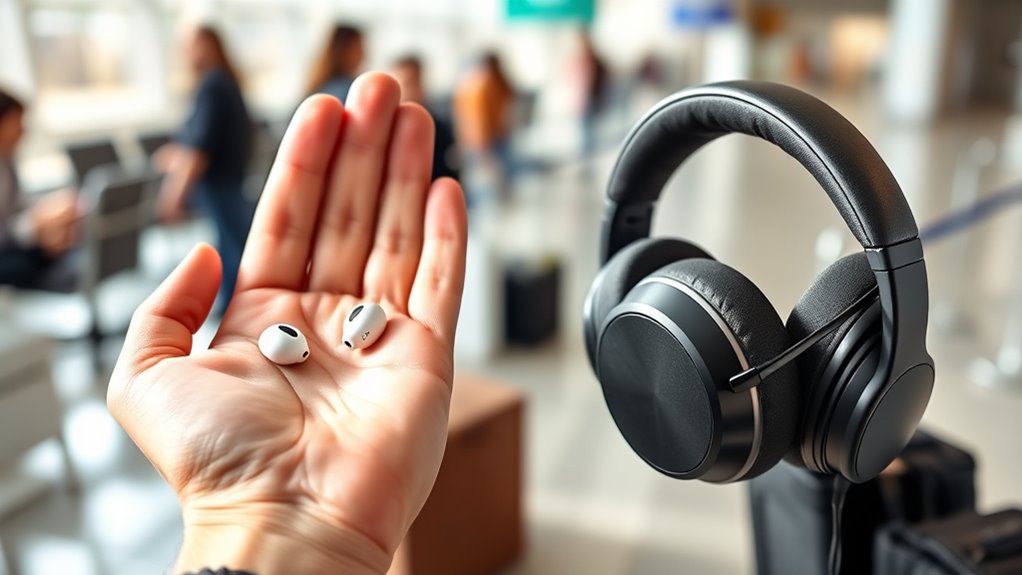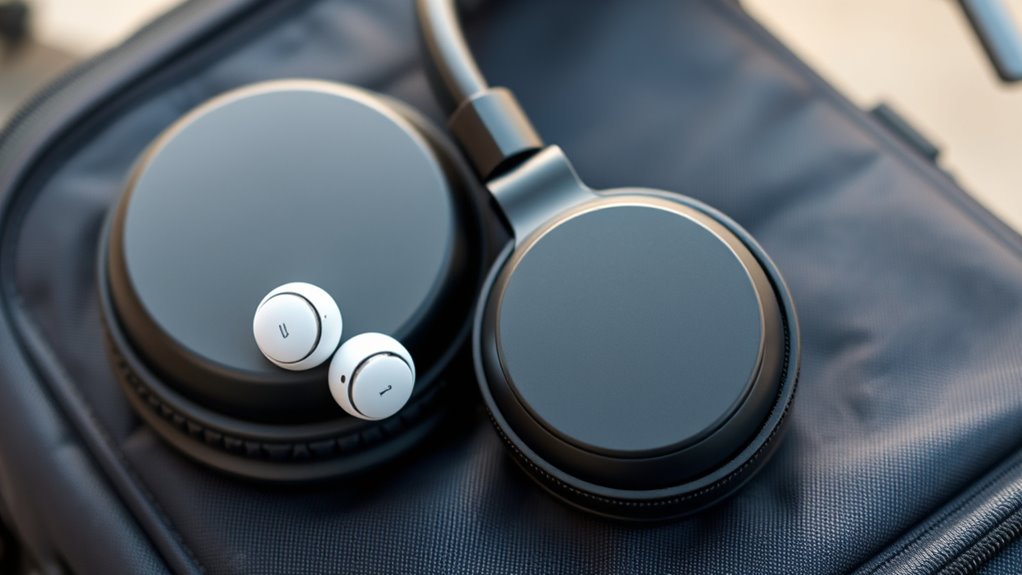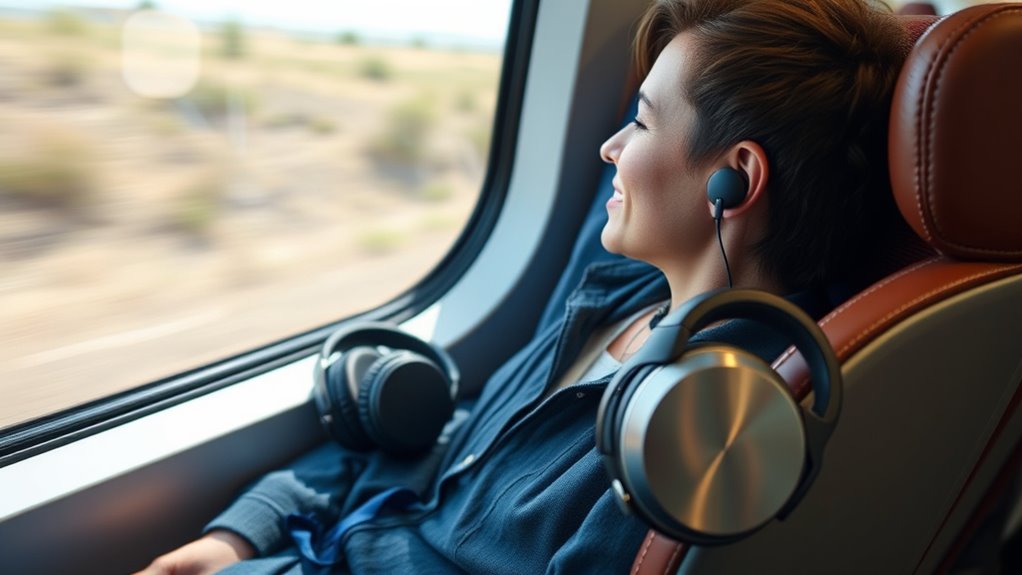When choosing between noise-canceling earbuds and headphones for travel, consider your priorities. Earbuds are compact, lightweight, and easy to carry, making them perfect for on-the-go use. Headphones often offer richer sound and better active noise cancellation for relaxing long journeys. Comfort and battery life also matter, so pick what’s best for your needs. To find out which suits your travel style, explore more about their features and benefits below.
Key Takeaways
- Headphones generally provide superior active noise cancellation and richer sound, ideal for immersive travel experiences.
- Earbuds are more portable, lightweight, and discreet, making them convenient for on-the-go use.
- Both options vary in comfort; ergonomic design and fit influence long-term wear during travel.
- Premium headphones often feature advanced noise cancellation, while earbuds rely on passive isolation or basic active cancellation.
- Consider personal preferences, environment, and budget to choose the best noise-canceling device for travel.
Sound Quality and Noise Cancellation Capabilities

When comparing noise-canceling earbuds and headphones, sound quality and noise cancellation capabilities are key factors to contemplate. Earbuds often provide impressive wireless connectivity, allowing you to enjoy high-quality audio directly from your device without cables. Headphones, on the other hand, generally deliver richer sound with deeper bass, enhancing overall listening. Durability features also matter; sturdy build quality guarantees your device withstands daily wear and tear, whether you’re commuting or traveling. Noise cancellation performance varies between models—some earbuds offer effective passive isolation, while premium headphones often feature advanced active noise cancellation for a more immersive experience. Additionally, the tuning methods used in different models can significantly influence sound clarity and overall performance. Ultimately, your choice depends on your preference for sound clarity, how well the device manages noise, and its durability to last through frequent use. Additionally, considering the vulnerabilities and safety measures in AI technology, such as AI security protocols, can inform decisions about integrating smart tech into your travel accessories.
Comfort and Fit for Long Journeys

Comfort and fit are essential factors to consider for long journeys, as they directly impact your listening experience and overall satisfaction. An ergonomic design ensures that earbuds or headphones sit comfortably without causing fatigue or discomfort over hours of use. Look for devices with adjustable fit options, such as customizable ear tips or headbands, so you can find the perfect, secure fit. Well-designed comfort features prevent slipping and reduce pressure on your ears or head, allowing you to relax and enjoy your music or podcasts during extended travel. Whether you prefer earbuds that nestle snugly or headphones with cushioned ear cups, prioritizing ergonomic design and adjustable fit helps make long journeys more enjoyable and less intrusive. Additionally, considering comfort and fit can help prevent discomfort that might lead to the need for frequent adjustments or removal, which can disrupt your listening experience. Opting for innovative materials that are lightweight and breathable can further enhance comfort during prolonged use. Incorporating a variety of ear tip sizes can also improve the overall fit and seal, enhancing both comfort and sound quality during extended wear. Moreover, selecting earbuds or headphones with proper weight distribution reduces strain on your ears and head, making extended listening sessions more comfortable and less fatiguing. Choosing a durable and supportive design can also ensure that your earbuds or headphones withstand the rigors of travel and prolonged use.
Portability and Ease of Use

Portability and ease of use are essential considerations when choosing noise-canceling earbuds or headphones, especially for on-the-go lifestyles. Earbuds typically shine here, thanks to their compact size and small storage options, making them easy to carry in pockets or small cases. Wireless connectivity simplifies your experience, allowing you to connect quickly without tangled cords. Headphones, on the other hand, often come with foldable designs and carrying cases that enhance portability, but they may be bulkier. Ease of use also means quick pairing and simple controls, which both devices aim to provide. Consider how you’ll store them when traveling; earbuds generally take up less space, but some headphones offer foldable designs for better storage options. Overall, earbuds tend to be more portable and easier to manage on the move. Additionally, many noise-canceling earbuds incorporate compact designs that make them even more convenient for travel. When selecting between the two, it’s helpful to think about battery life, as earbuds often have shorter durations compared to over-ear headphones, which can impact long travel days. Advances in technological advancements in noise cancellation also improve their effectiveness during travel. Moreover, the popularity of wireless devices has driven innovations in how these products are designed for portability and ease of use. Furthermore, considering user comfort is crucial since prolonged wear can affect your overall experience during travel.
Battery Life and Power Options

Battery life and power options play a significant role in determining how well your noise-canceling earbuds or headphones fit into your daily routine. Longer battery longevity means you can enjoy hours of uninterrupted listening without worry. Wireless charging adds convenience, letting you power up effortlessly during travel or breaks. If your device offers quick charge features, a few minutes of charging can deliver hours of use. Consider whether your earbuds or headphones support power-saving modes to extend battery life further. Additionally, compatibility with fast charging technologies can significantly reduce downtime between uses. Features like automatic power-off can also help conserve battery when the device is idle. Incorporating battery management features can optimize overall device performance and longevity. Being mindful of battery capacity can help you select devices that better meet your usage needs, especially for extended travel or daily commutes.
Price Range and Value for Travelers

When choosing noise-canceling earbuds or headphones for travel, price often reflects the overall value you obtain in features, durability, and sound quality. Budget options are available that provide decent noise cancellation and sound performance at a lower cost, making them ideal if you’re on a tight budget. However, if you’re willing to invest in premium features like superior comfort, adaptive noise cancellation, and longer-lasting build quality, higher-end models deliver better value in the long run. Consider your travel needs and how much you’re willing to spend, as a higher price often means better durability and more advanced features. Additionally, understanding sound design principles can help you appreciate how different models create immersive audio experiences. For example, some models incorporate advanced noise reduction technologies that significantly enhance the listening experience. Moreover, familiarity with personality traits can sometimes influence your preferences for specific audio devices, as certain personalities may prioritize comfort or technical features differently. Investing in models with good noise cancellation can also improve your overall travel experience by reducing ambient noise and allowing you to focus on enjoying your audio. Furthermore, being aware of environmental considerations can help you select devices that are more eco-friendly and sustainable. Ultimately, finding the right balance between affordability and quality will ensure you get the most value for your money.
Frequently Asked Questions
Can Noise-Canceling Earbuds Cause Ear Fatigue During Extended Use?
Yes, noise-canceling earbuds can cause ear fatigue during extended use. The active noise cancellation creates ear pressure, which might lead to discomfort or ear pressure buildup. If you wear them for long periods, you could experience ear discomfort or even mild pain. To avoid this, take breaks regularly, guarantee a proper fit, and avoid prolonged use without giving your ears some rest.
Are There Specific Travel Scenarios Where Headphones Outperform Earbuds?
In certain travel scenarios, headphones often outperform earbuds. For example, during long flights, 65% of travelers find over-ear headphones more comfortable for extended wear, providing better in-flight comfort. They also offer a secure fit, reducing the risk of slipping out, which is key for security concerns. If you prefer a snug, comfortable fit and better noise isolation, headphones are the ideal choice for lengthy journeys.
How Do Earbuds and Headphones Handle Ambient Noise in Busy Environments?
You’ll find that noise-canceling headphones generally offer better ambient noise reduction in busy environments, blocking out more background sounds effectively. Earbuds with active noise cancellation can also improve ambient noise reduction, but they tend to have more sound leakage, which might bother others nearby. Headphones provide a more immersive experience, making it easier to focus, while earbuds are more discreet and portable for quick noise reduction on the go.
Do Noise-Canceling Features Affect Hearing Health Over Time?
Think of noise-canceling features like a superhero shield—protecting you but requiring caution. Over time, they can contribute to hearing loss or hearing fatigue if you listen at high volumes or for long periods. While they’re safe when used responsibly, prolonged exposure at loud levels may harm your hearing health. Always monitor volume and take breaks to keep your ears safe, just like you’d wear sunscreen to avoid sunburn.
Are Wireless Options More Reliable Than Wired for Travel Convenience?
Wireless options are generally more convenient for travel because you don’t have to deal with tangled cords, making them easier to carry around. However, wired headphones often offer better durability and consistent sound quality, especially if you prefer classic reliability. You’ll find wireless devices more flexible, but if durability is your priority, wired options can be more dependable during long trips. Choose based on your travel needs and priorities.
Conclusion
Ultimately, choosing between noise-canceling earbuds and headphones depends on your travel style. Imagine a peaceful oasis amid chaos—whether it’s the compact earbuds that slip unnoticed or the headphones that envelop you in serenity. Think about what matters most: convenience, comfort, or sound quality. Whichever you pick, let it be your trusted companion, transforming noisy journeys into tranquil escapes. After all, your perfect travel partner is the one that makes every trip feel like a breeze.








